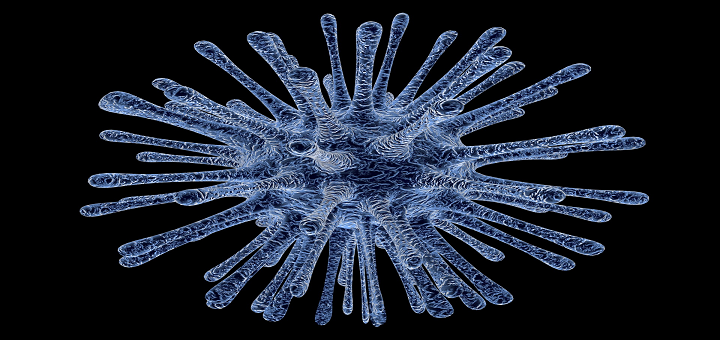by Margaret Williams - 30th December 2009

For decades it has been known and shown that viruses play a role in ME/CFS. Now there is evidence of a direct association with a gamma retrovirus – XMRV -- that disables the immune system in ME/CFS, thus allowing numerous latent viruses to re-activate, which could result in the protean symptomatology. As Professor Nancy Klimas said in her November 2009 lecture at the University of Miami:
“We’ve always thought something like that has to go on in (ME) CFS because you all have some neuro-inflammation. Your brain has a low grade level of inflammation. And you have some inflammation in the tissues that make hormones, particularly in the hypothalamic-pituitary-axis. And this is a virus that infects that type of tissue…” (see below).
Latent viruses that have been particularly studied in relation to ME/CFS include Coxsackie B virus (CBV), Epstein Barr virus (EBV) and human herpes virus-6 (HHV-6), and illustrations are provided below.
However, advised by psychiatrists of the Wessely School, in the UK the NICE Guideline of 2007 recommends limited serology testing for certain viruses only, which excludes testing for Coxsackie B virus, for which there is the most evidence (testing for Epstein Barr Virus, a particular interest of Professor Peter White is, however, permitted).
Given that a classified synonym for ME/CFS is “post-viral fatigue syndrome” (ICD-10 G93.3) and given that, like the MRC PACE Trial, the NICE Guideline purports to apply to people with “CFS/ME”, it is striking that the Guideline states on page 141:
“Serological testing should not be carried out unless the history is indicative of an infection”.
It is notable that the PACE Trial Investigators did not include virological testing of participants in their trial that is based on their theory that patients with “CFS/ME” are merely deconditioned, so it needs to be ascertained what, exactly, do the Wessely School psychiatrists understand the term “post-viral” to mean if not a history indicative of an infection?
The following are illustrations of viral involvement in ME/CFS:
1954
Describing an outbreak of infection of the central nervous system complicated by intense myalgia in late summer 1952 affecting nurses at the Middlesex Hospital, London, the author (ED Acheson, who later became UK Chief Medical Officer) reported the clinical features to be severe muscular pain affecting the back, limbs, abdomen and chest, with evidence of mild involvement of the central nervous system, diarrhoea, vomiting, respiratory distress, paresis and brain stem involvement that included nystagmus, double vision and difficulty in swallowing; additionally, bladder symptoms occurred in more than half the patients. Acheson highlighted this small outbreak because of the similarity to atypical poliomyelitis (ED Acheson. Lancet: Nov 20th 1954:1044-1048). The label of “atypical poliomyelitis” was originally given to ME (The Disease of a Thousand Names. David S Bell. Pollard Publications, Lyndonville, New York, 1991).
Many patients today experience exactly the symptoms described by Acheson, but such symptoms are dismissed by the Wessely School as somatisation and as hypervigilance to normal bodily sensations.
1955
Acheson described and compared the outbreak at the Royal Free in 1955 with the outbreak at The Middlesex in 1952, noting the relatively prolonged active course of the disease, marked muscular pain and spasm, involvement of the lymph nodes, liver and spleen, tenderness under the costal margins, and ulcers in the mouth, all of which – if looked for and if not dismissed as somatising -- are still to be found in “pure” ME today (ED Acheson. Lancet: Aug 20th 1955:394-395).
1959
In his detailed review of numerous outbreaks of Benign Myalgic Encephalomyelitis from 1934, Acheson described the common characteristics of the disease and clinical picture, which included agonising muscular pain, headache, nausea, sensory disturbances, stiffness of the neck and back, dizziness, muscular twitching, tremor and in-coordination, localised muscular weakness, emotional lability, problems with memory and concentration, hyperacusis, somnolence and insomnia, with relapses being almost inevitable, together with variability of symptoms. Signs included hepatic enlargement, lymphadenopathy and evidence of CNS involvement, nystagmus being “almost invariable” in some of the outbreaks. The question of hysteria was addressed and discounted: “Final points against mass hysteria as a major factor in the syndrome are the consistency of the course of the illness and the similarities in the symptoms…The disorder is not a manifestation of mass hysteria” and Acheson specifically warned that the diagnosis of ME should be reserved for those with (virally induced) evidence of CNS damage:
“If not, the syndrome will become a convenient dumping ground for non-specific illnesses characterised by fluctuating aches and pains, fatigue and depression”, exactly the situation that exists in the UK 50 years after Acheson’s prophecy
(ED Acheson. American Journal of Medicine, April 1959:569-595).
“The clinical picture was variable both in the time pattern of its progression and the severity of the symptoms…It became clear early on in the outbreak that there was organic involvement of the central nervous system (and) there was objective evidence of involvement of the central nervous system…The most characteristic symptom was the prolonged painful muscle spasms…Bladder dysfunction occurred in more than 25% of all the patients…Case to case contact between patients and their relatives also occurred… McEvedy and Beard’s conclusions (of mass hysteria) ignore the objective findings of the staff of the hospital of fever, lymphadenopathy, cranial nerve palsies and abnormal signs in the limbs…Objective evidence of brain stem and spinal cord involvement was observed”
(Nigel D Compston. Postgraduate Medical Journal 1978:54:722-724).
“Virological studies revealed that 76% of the patients with suspected myalgic encephalomyelitis had elevated Coxsackie B neutralising titres (and symptoms included) malaise, exhaustion on physical or mental effort, chest pain, palpitations, tachycardia, polyarthralgia, muscle pains, back pain, true vertigo, dizziness, tinnitus, nausea, diarrhoea, abdominal cramps, epigastric pain, headaches, paraesthesiae, dysuria)….The group described here are patients who have had this miserable illness. Most have lost many weeks of employment or the enjoyment of their family (and) marriages have been threatened…”
(BD Keighley, EJ Bell. JRCP 1983:33:339-341).
“…from an immunological point of view, patients with chronic active EBV infection appear ‘frozen’ in a state typically found only briefly during convalescence from acute EBV infection”
(G Tosato, S Straus et al. The Journal of Immunology 1985:134:5:3082-3088. Note that ”CFS” was then thought to be caused by EBV).
“Epstein-Barr virus infection may have induced or augmented an immunoregulatory disorder that persisted in these patients”
(Stephen E Straus et al. Ann Intern Med. 1985:102:7-16).
“The clinical, pathological, electrophysiological, immunological and virological abnormalities in 50 patients with the postviral fatigue syndrome are recorded. These findings confirm the organic nature of the disease (and) suggest that it is associated with disordered regulation of the immune system and persistent viral infection”
(PO Behan, WMH Behan, EJ Bell. Journal of Infection 1985:10:211-222.
“Ninety percent of the patients tested had antibodies to Epstein-Barr virus and 45% tested had antibodies to cytomegalovirus…if this fatigue syndrome is triggered by an infectious agent, an abnormal immune response may be involved”
(TJ Marrie et al. Clinical Ecology 1987:V:1:5-10).
“Recently associations have been found between Coxsackie B infection and a more chronic multisystem illness. A similar illness…has been referred to as… myalgic encephalomyelitis…140 patients presenting with symptoms suggesting a postviral syndrome were entered into the study…Coxsackie B antibody levels were estimated in 100 control patients…All the Coxsackie B virus antibody tests were performed blind…Of the 140 ill patients, 46% were found to be Coxsackie B virus antibody positive…This study has confirmed our earlier finding that there is a group of symptoms with evidence of Coxsackie B infection. We have also shown that clinical improvement is slow and recovery does not correlate with a fall in Coxsackie B virus antibody titre”
(BD Calder et al. JRCGP 1987:37:11-14).
“The illness has an acute onset after a variety of infections and then enters a chronic phase characterised by fatigue and numerous other symptoms….Other findings include a sleep disorder, mild immunodeficiency, slightly low complement, anti-DNA antibodies and elevated synthetase which is an interferon-associated enzyme commonly increased in viral infections”
(Irving E Salit. Clinical Ecology 1987:V:3:103-107).
“These results show that chronic infection with enteroviruses occurs in many PVFS (post-viral fatigue syndrome, a classified synonym for ME/CFS) patients and that detection of enterovirus antigen in the serum is a sensitive and satisfactory method for investigating infection in these patients….Several studies have suggested that infection with enteroviruses is causally related to PVFS…The association of detectable IgM complexes and VP1 antigen in the serum of PVFS patients in our study was high…This suggests that enterovirus infection plays an important role in the aetiology of PVFS”
(GE Yousef, EJ Bell, JF Mowbray et al. Lancet January 23rd 1988:146-150).
“Myalgic encephalomyelitis was thought for some time to be produced by a less virulent strain of poliovirus…chronic, persistent viruses may often be reactivated during this illness…once reactivated, do these viruses then go on to produce many of the symptoms of the disease? And what reactivates these endogenous viruses? Could it be environmental toxins? Could it be infection with other, exogenous lymphotropic viruses?”
(Anthony L Komaroff. Journal of Virological Methods. 1988:21:3-10).
(In the light of the discovery in 2009 of the XMRV retrovirus – see below -- this paper by Professor Komaroff 21 years in advance of that discovery showed remarkable prescience). 1988
“Postviral fatigue syndrome / myalgic encephalomyelitis… has attracted increasing attention during the last five years…Its distinguishing characteristic is severe muscle fatiguability made worse by exercise…The chief organ affected is skeletal muscle, and the severe fatiguability, with or without myalgia, is the main symptom. The results of biochemical, electrophysiological and pathological studies support the view that muscle metabolism is disturbed, but there is no doubt that other systems, such as nervous, cardiovascular and immune are also affected…Recognition of the large number of patients affected…indicates that a review of this intriguing disorder is merited….The true syndrome is always associated with an infection…Viral infections in muscle can indeed be associated with a variety of enzyme abnormalities…(Electrophysiological results) are important in showing the organic nature of the illness and suggesting that muscle abnormalities persist after the acute infection…there is good evidence that Coxsackie B virus is present in the affected muscle in some cases”
(PO Behan, WMH Behan. CRC Crit Rev Neurobiol 1988:4:2:157-178).

